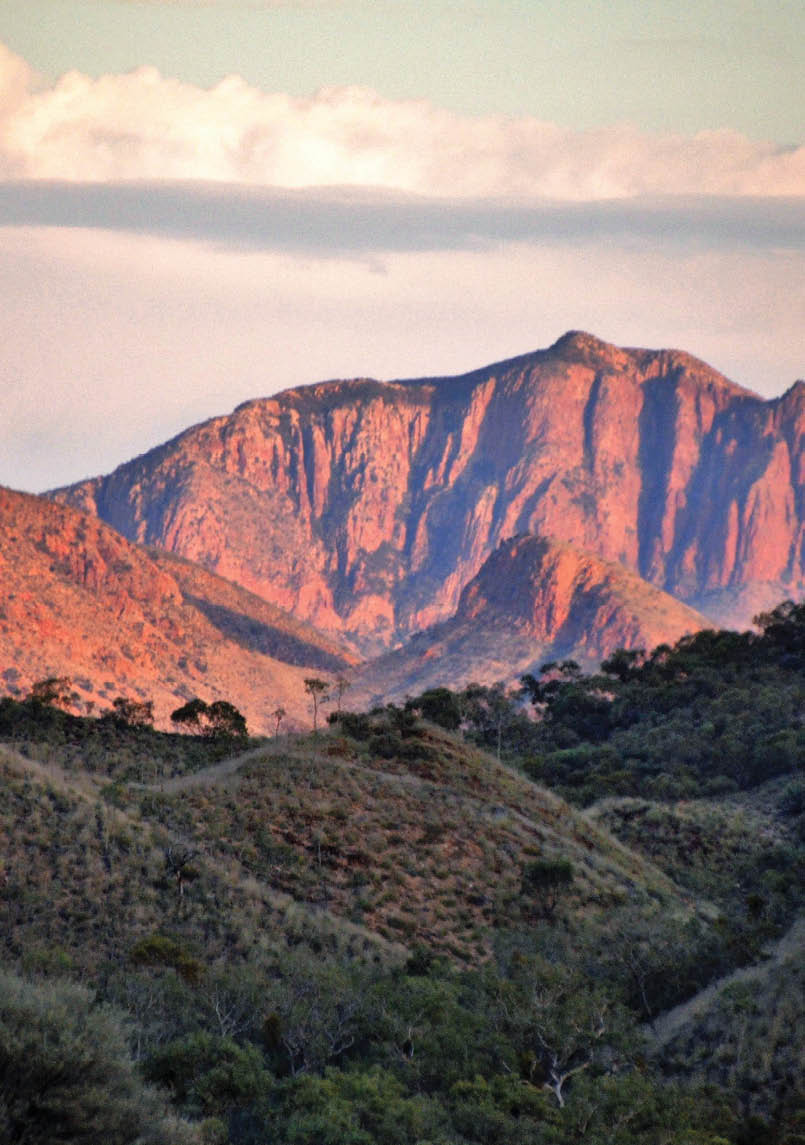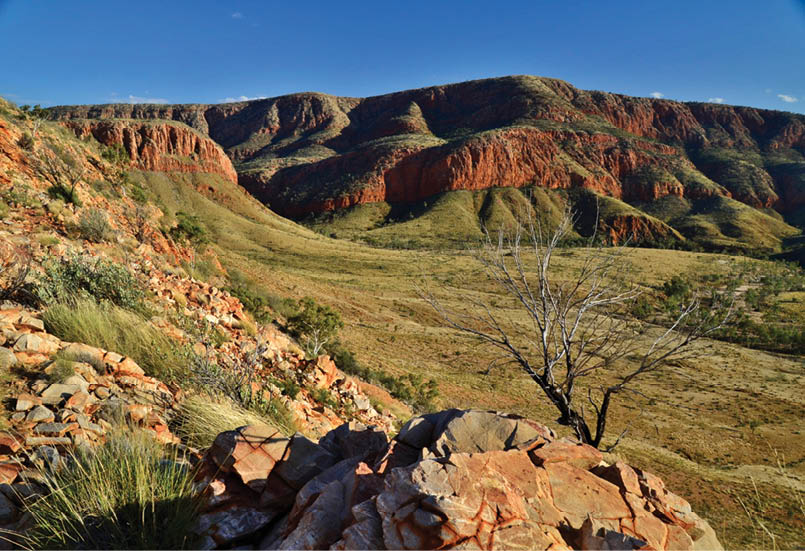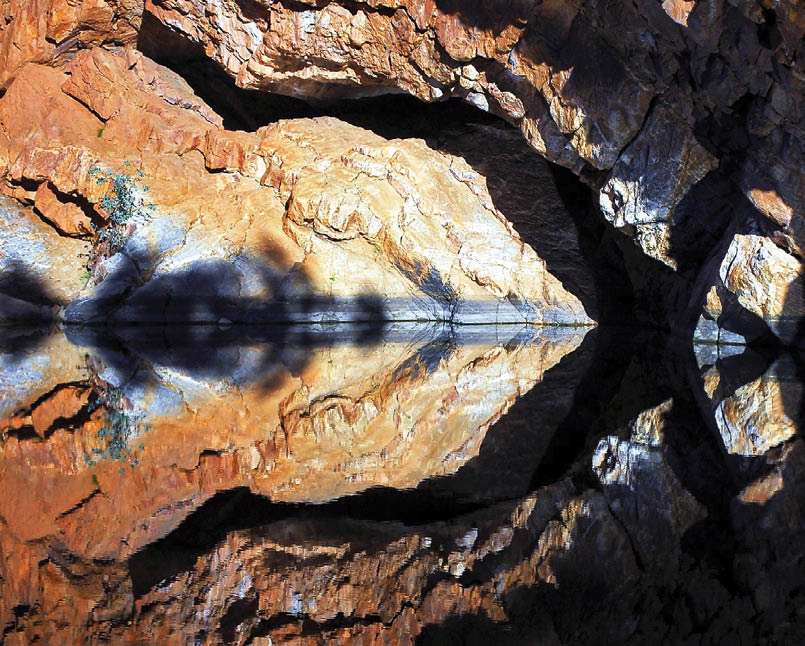

Ormiston GorgeAll photos by Ian Smith
Ian's latest excursion story, this time through the dream land of Central Australia in the Western McDonnell Ranges.

Namatjira DreamingIan Smith

6 | BWA April 2022


It’s odd how selective one’s memory can be. I couldn’t tell you when my parents passed on, but I can remember sitting in our local cinema at Teralba, the town where I was raised, and seeing a black and white newsreel of Albert Namatjira being presented to the queen.
Photographs of his work were shown and immediately I liked what I saw. At that time, in 1954, Albert was at the peak of his powers, but other aspects of his life were in tatters. He’d been granted a grazing licence but had it taken away less than a year later. He bought a block of land in Alice Springs but wasn’t allowed to build on it due to the racial climate of the day.
He’d married outside his “skin” and had been ostracised by the Aboriginal community, but when he started making money, he had up to 600 people wanting a “share”.
Eventually, in 1957, he was granted citizenship, the first Aboriginal to be so blessed, which seems totally weird in today’s more enlightened times. The appalling prejudice that existed then didn’t allow native Australians rights in their own country.
Sadly, being granted these rights allowed him to buy alcohol which made him more in demand and, when sharing some with fellow artist Henoch Raberaba, he was arrested and got six months’ gaol, later commuted to three months, but he survived only days after his release and died of congenital heart failure in 1959. The main reason he was arrested was because an Aboriginal woman had been killed due to an alcohol inflamed argument, alcohol that Albert had indirectly supplied.
By then, his legacy was writ large on the landscape. The first indigenous person to be painted (by William Dargie) and win the Archibald Prize; he was the first Aboriginal to have his portrait on a postage stamp. Though talented at many forms of art, his outback watercolours, prompted by his mentor Rex Battarbee, are what Namatjira will be remembered for. Battarbee had been badly wounded in WWI and, unable to do heavy manual work, turned to art.
Over 60 years later, it’s hard to believe my memory of Namatjira stuck, but when I first visited Hermannsburg, the village of
Ormiston Gorge
BWA April 2022 | 7

his origin, I could sense something. Then I walked into a dilapidated building and the spirit was here. Relatives and friends had their works hanging on the wall in what should have been a serious attraction, but only two lights were working in the four rooms, and you mainly relied on the dim light from outside to see the paintings and read biographies of the artists. Sadness was my main emotion when I left there.
Still, I reasoned that he had left people like me a legacy and I might have the opportunity now to pass it on.
Next, at Ormiston Gorge, I was primed for the Pound Walk; I’d pigged out on my Weetbix ration, all packed up with camera gear and was on my way before the sun flooded the camp. I hoped I’d be first away, but there was a Swedish couple reading the information board when I rolled up.
A minute later I headed off, strolling down to Ormiston Creek and beyond, heading east along a grassy valley on a well-worn narrow track. It was in shadow almost all the way until the trail rose from the water and went over a pass where I glanced back to see Mount Sonder being woken by the sun’s early rays.
After about three kilometres there’s a 500 metre diversion to the Pound View lookout. The walk went from ordinary to spectacular up the ridge with grand views in all directions. The soft light of post-dawn highlighted the ridges and the furrows of an aged landscape in the distant gorge. “In these timeless surrounds, it is easy to believe that civilisation is light years away”, said the sign back at the camp.
On these walks you can’t help but feel the power of nature, and begin to understand the spiritualism associated with such
Ormiston Gorge
8 | BWA April 2022

places; surely they inspire us and deserve our reverence. Albert is writ large upon this landscape, not only on the interpretive signs but in what he felt for the land.
I like to think I felt a lot of it too on this walk; at certain ghost gums I feel I paused beside him, felt his presence as we gazed at the majesty before us. At one of the white trunks beside stagnant ponds I framed the tree around the range beyond before clicking and swore I had seen this image in a painting. Tramping on, a knowledge that this had changed something inside me wouldn’t go away; I felt a refreshing insight into why indigenous people respect the land.Across the plain I stroll until the river is reached. Ormiston Creek is a tributary of the Finke River, the Territory’s longest … well, when it flows anyway. Down here, the stagnant ponds are the key to life; dragonflies, wasps, bees and all manner of other insects abound.
Returning to the trail, the colours of Ormiston were omnipresent as a purple layer was exposed below the bright orange cliffs and the occasional ghost gum, whose amazing roots reach all the way to the water table, stood out in stark contrast. I reached the long pool about the same time as a Swiss couple who were shaking their heads when they realised that, just across the water, was the place where they’d thought the trail had finished. After three hours of chasing me, they still had to cross it anyway, only from the opposite direction.
With due respect, we took off the requisite amount of clothing, in my case down to my underwear, and it still got a touch damp during the fording. I short-circuited along the bank and took the easy route back to camp where I lathered in the joy of a cool shower.I’d had an experience with Albert, and it had been special.
Ormiston Gorge
BWA April 2022 | 9